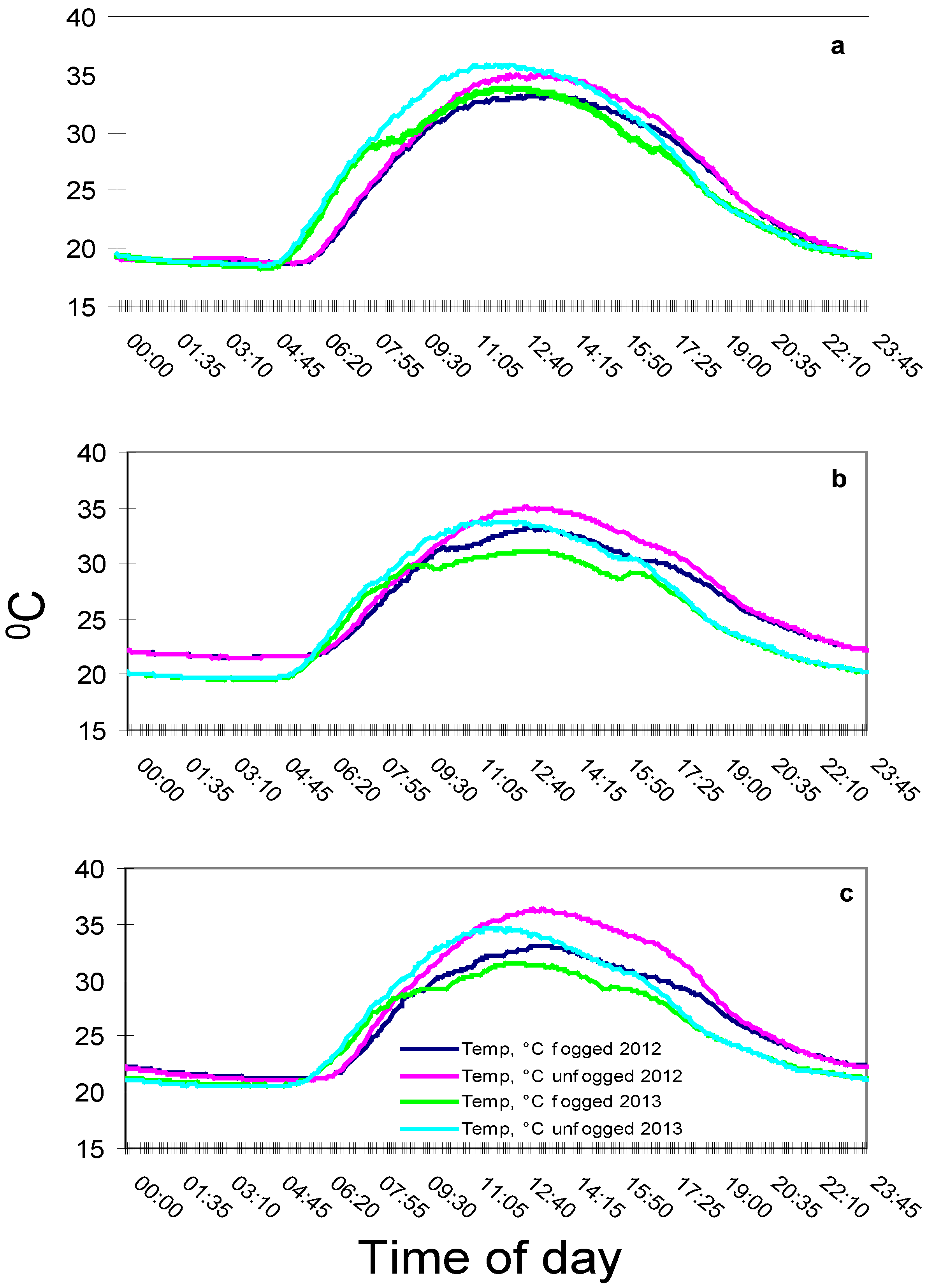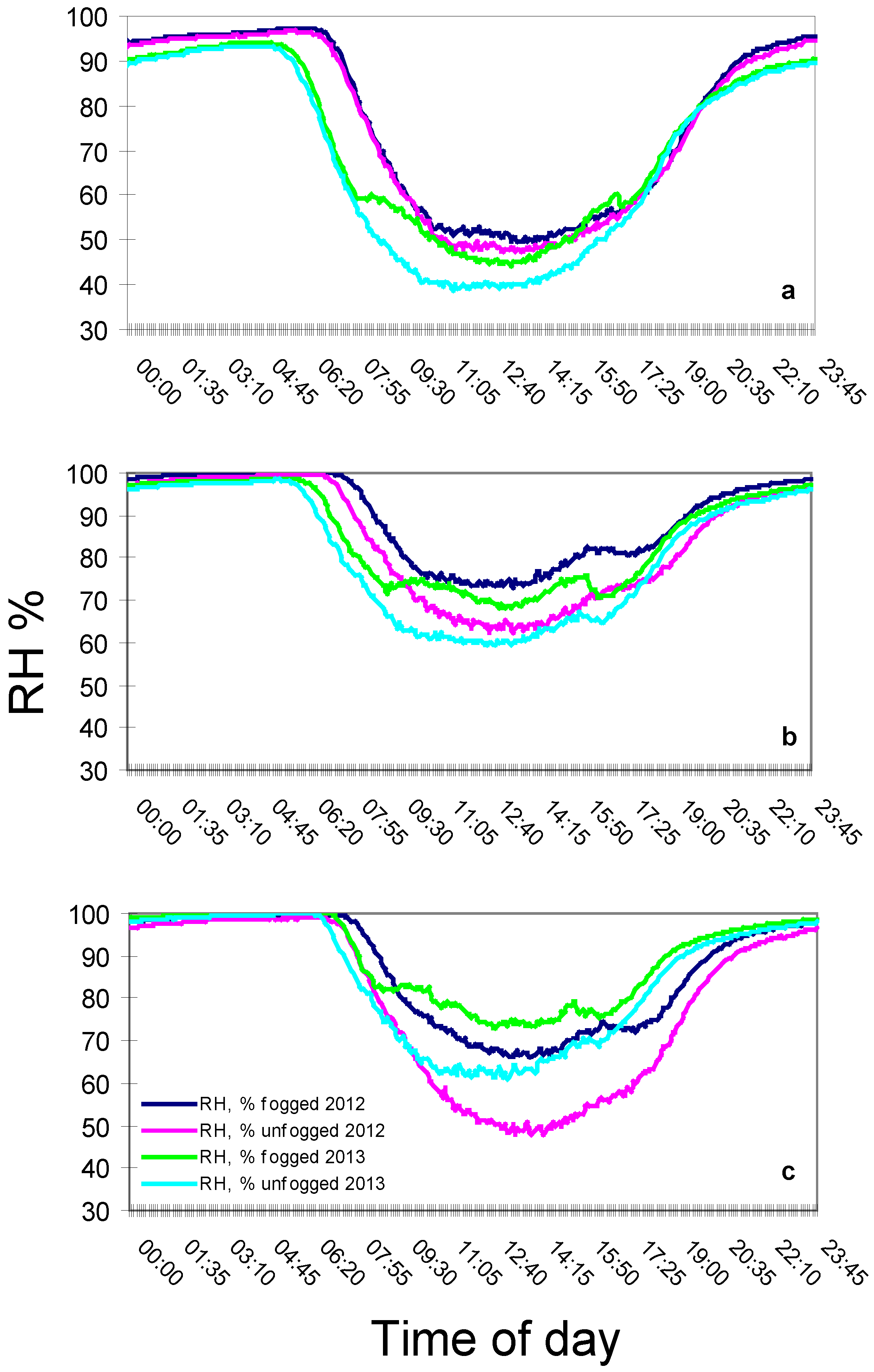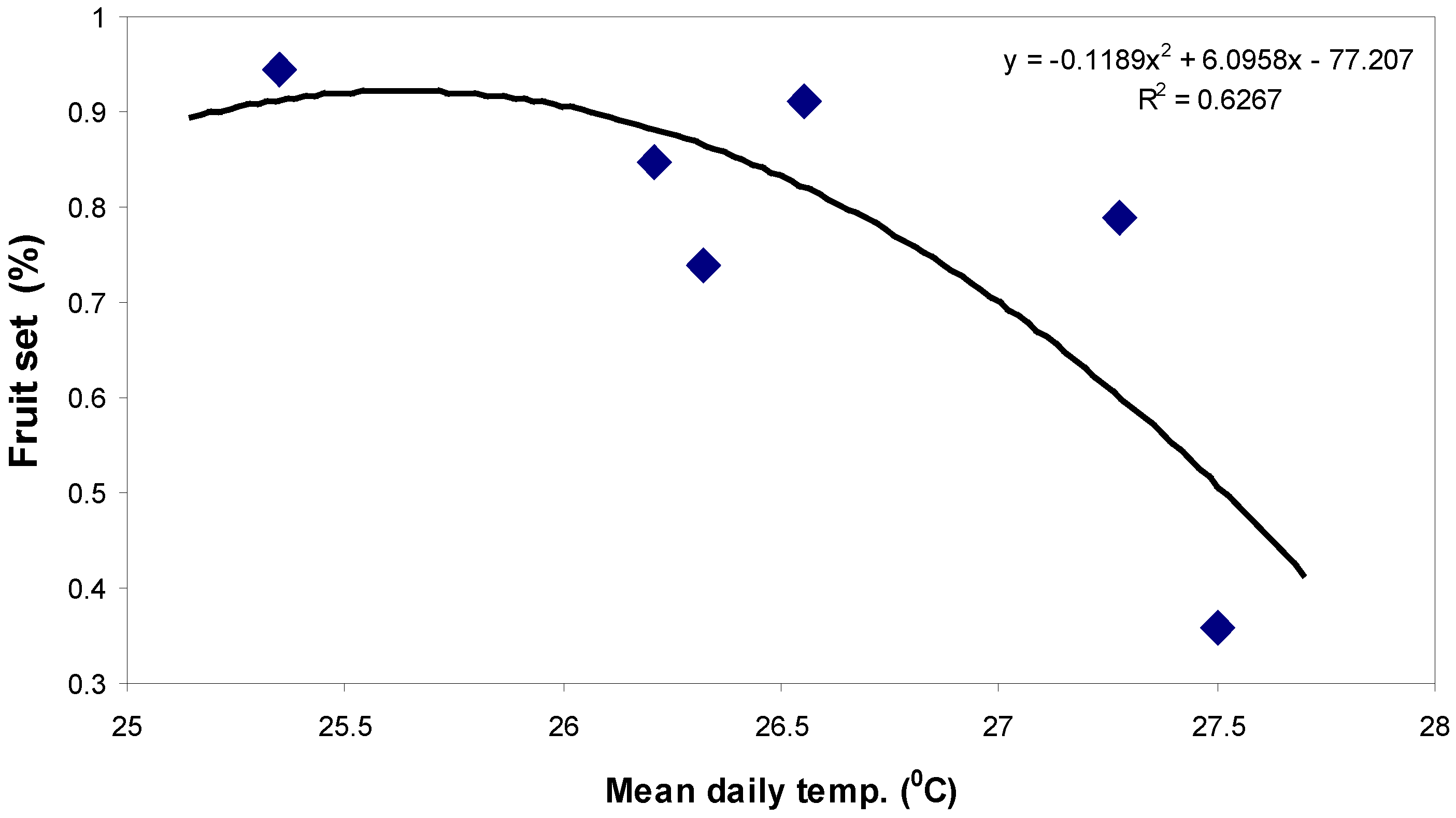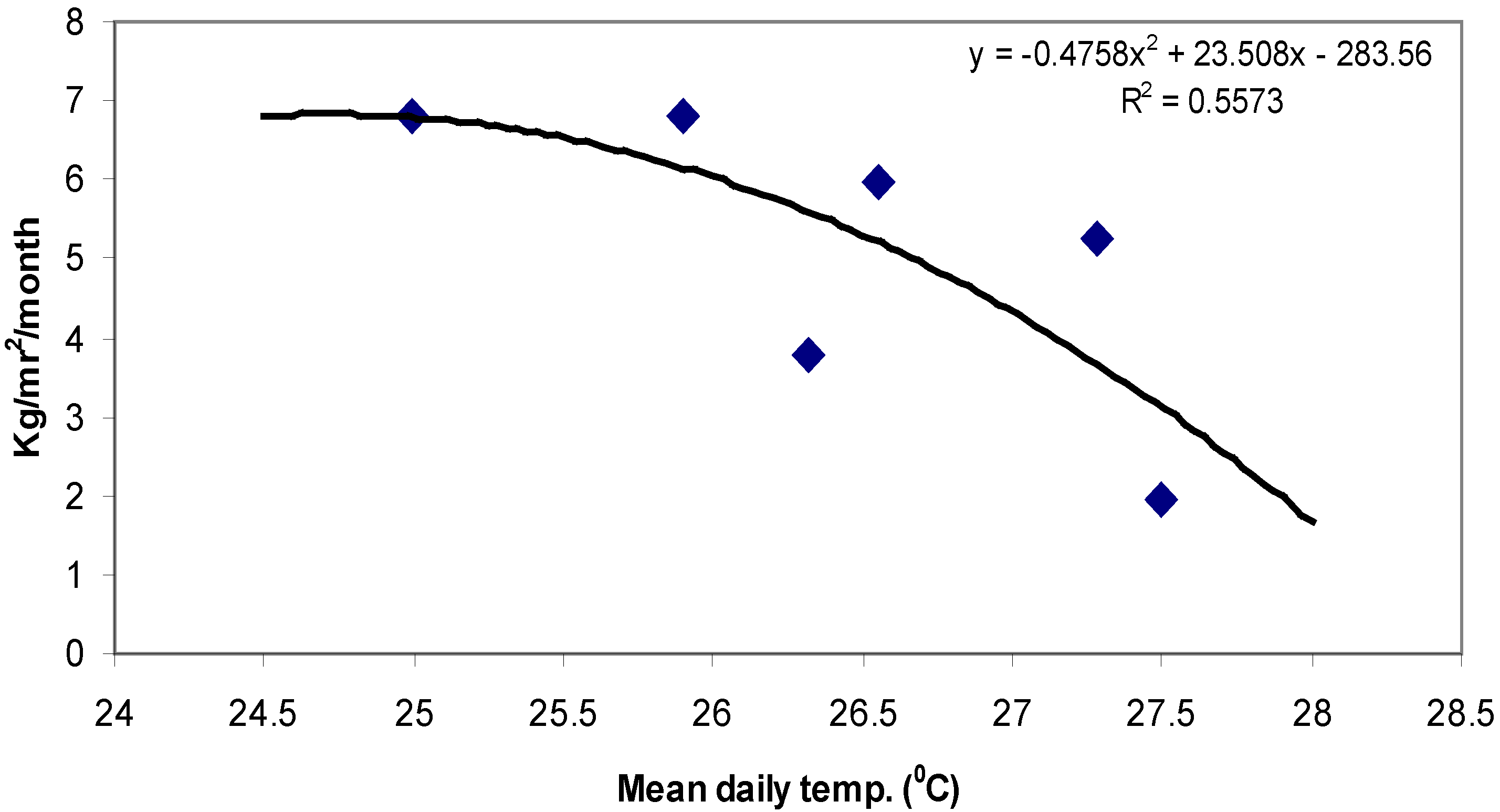The Effect of Mean Daily Temperature and Relative Humidity on Pollen, Fruit Set and Yield of Tomato Grown in Commercial Protected Cultivation
Abstract
:1. Introduction
2. Results and Discussion
2.1. Daily Mean Air Temperature and Relative Humidity


2.2. Pollen Quality in Relation to Mean Daily Temperatures and RH
| Treatment | Sampling date | Mean daily temp. (°C) | Germinated (%) | Viable (%) | Non-viable (%) |
|---|---|---|---|---|---|
| Unfogged | July 2012 | 27.3 | 1.24 ± 0.9 | 63.68 ± 4.6a | 35.08 ± 4.5a |
| Fogged | 26.5 | 3.14 ± 1.4 | 83.65 ± 2.8b | 13.21 ± 3.1b | |
| Unfogged | August 2012 | 27.5 | 5.47 ± 1.7 | 59.58 ± 6.8a | 34.95 ± 7.1a |
| Fogged | 26.3 | 3.12 ± 0.5 | 91.46 ± 1.5b | 5.42 ± 1.8b | |
| Unfogged | September 2012 | 26.3 | 3.79 ± 0.7a | 62.5 ± 4.3a | 33.71 ± 4.1a |
| Fogged | 25.2 | 9.33 ± 0.8b | 86.92 ± 1b | 3.75 ± 1b | |
| Unfogged | July 2013 | 25.9 | 13.58 ± 3.4 | 74.33 ± 4.3a | 12.09 ± 2.3a |
| Fogged | 25 | 12.84 ± 1.5 | 83.45 ± 1.9b | 3.71 ± 0.9b | |
| Unfogged | August 2013 | 26.3 | 14.35 ± 3.4 | 78.33 ± 4.1 | 7.32 ± 1.9a |
| Fogged | 25.3 | 15.55 ± 2.3 | 82.7 ± 1.8 | 1.75 ± 0.6b |

2.3. Fruit Set and Fruit Yield in Relation to Mean Daily Air Temperature


2.4. Discussion
3. Experimental Section
3.1. Plant Cultivation
3.2. Net House, Fogging System and Climate Data Collection
3.3. Mature Pollen Quality
3.4. Data Analysis
4. Conclusions
Acknowledgments
Conflicts of Interest
References
- Sato, S.; Peet, M.M.; Thomas, J.F. Determining critical pre-and post-anthesis periods and physiological processes in Lycopersicon esculentum Mill. exposed to moderately elevated temperatures. J. Exp. Bot. 2002, 53, 1187–1195. [Google Scholar]
- Sato, S.; Kamiyama, M.; Iwata, T.; Makita, N.; Furukawa, H.; Ikeda, H. Moderate increase of mean daily temperature adversely affects fruit set of Lycopersicon esculentum by disrupting specific physiological processes in male reproductive development. Ann. Bot. 2006, 97, 731–738. [Google Scholar] [CrossRef]
- Pressman, E.; Peet, M.M.; Pharr, D.M. The effect of heat stress on tomato pollen characteristics is associated with changes in carbohydrate concentration in the developing anthers. Ann. Bot. 2002, 90, 631–636. [Google Scholar] [CrossRef]
- Nepi, M.; Cresti, L.; Guarnieri, M.; Pacini, E. Effect of relative humidity on water content, viability and carbohydrate profile of Petunia hybrida and Cucurbita pepo pollen. Plant Syst. Evol. 2010, 284, 57–64. [Google Scholar] [CrossRef]
- Peet, M.; Sato, S.; Clément, C.; Pressman, E. Heat stress increases sensitivity of pollen, fruit and seed production in tomatoes (Lycopersicon esculentum Mill.) to non-optimal vapor pressure deficits. Int. Hortic. Congr.: Environ. Stress Hortic. Crop. 2002, 618, 209–215. [Google Scholar]
- Huang, Y.; Li, Y.; Wen, X. The effect of relative humidity on pollen vigor and fruit setting rate of greenhouse tomato under high temperature condition. Acta Agric. Boreali-Occident. Sin. 2011, 11, 1–20. [Google Scholar]
- Baille, A. Overview of greenhouse climate control in the mediterranean regions. Cahiers Op. 1999. Available online: http://om.ciheam.org/om/pdf/c31/CI020831.pdf (accessed on 26 February 2014).
- Harel, D.; Fadida, H.; Gantz, S.; Shilo, K.; Yasuor, H. Evaluation of low pressure fogging system for improving crop yield of tomato (Lycopersicon esculentum Mill.): Grown under heat stress conditions. Agronomy 2013, 3, 497–507. [Google Scholar] [CrossRef]
- Meca, D.; López, J.C.; Gázquez, J.C.; Baeza, E.; Pérez Parra, J.; Zaragoza, G. Comparison of three different cooling systems in parral type greenhouses in Almería. Span. J. Agric. Res. 2007, 5, 285–292. [Google Scholar] [CrossRef]
- Li, S.; Willits, D.H. Comparing low-pressure and high-pressure fogging systems in naturally ventilated greenhouses. Bios. Eng. 2008, 101, 69–77. [Google Scholar] [CrossRef]
- Li, S.; Willits, D.H.; Yunker, C.A. Experimental Study of Low Pressure Fogging System in Naturally Ventilated Greenhouses; American Society of Agricultural and Biological Engineers: St. Joseph, MI, USA, 2005. [Google Scholar]
- Peet, M.M.; Willits, D.H.; Gardner, R. Response of development and post-pollen production processes in sterile tomatoes to chronic sub-acute high temperature stress. J. Exp. Bot. 1997, 48, 101–111. [Google Scholar] [CrossRef]
- Beddington, J.; Asaduzzaman, M.; Clark, M. Achieving Food Security in the Face of Climate Change, final report from the Commission on Sustainable Agriculture and Climate Change; CGIAR Research Program on Climate Change, Agriculture and Food Security (CCAFS): Copenhagen, Denmark, 2012. [Google Scholar]
- Pressman, E.; Moshkovitch, H.; Rosenfeld, K.; Shaked, R.; Gamliel, B.; Aloni, B. Influence of low night temperatures on sweet pepper flower quality and the effect of repeated pollinations, with viable pollen, on fruit setting. J. Hortic. Sci. Biol. 1998, 73, 131–136. [Google Scholar]
- Alexander, M.P. A versatile stain for pollen fungi, yeast and bacteria. Biotech. Histochem. 1980, 55, 13–18. [Google Scholar] [CrossRef]
© 2014 by the authors; licensee MDPI, Basel, Switzerland. This article is an open access article distributed under the terms and conditions of the Creative Commons Attribution license (http://creativecommons.org/licenses/by/3.0/).
Share and Cite
Harel, D.; Fadida, H.; Slepoy, A.; Gantz, S.; Shilo, K. The Effect of Mean Daily Temperature and Relative Humidity on Pollen, Fruit Set and Yield of Tomato Grown in Commercial Protected Cultivation. Agronomy 2014, 4, 167-177. https://doi.org/10.3390/agronomy4010167
Harel D, Fadida H, Slepoy A, Gantz S, Shilo K. The Effect of Mean Daily Temperature and Relative Humidity on Pollen, Fruit Set and Yield of Tomato Grown in Commercial Protected Cultivation. Agronomy. 2014; 4(1):167-177. https://doi.org/10.3390/agronomy4010167
Chicago/Turabian StyleHarel, Danny, Hadar Fadida, Alik Slepoy, Shelly Gantz, and Kobi Shilo. 2014. "The Effect of Mean Daily Temperature and Relative Humidity on Pollen, Fruit Set and Yield of Tomato Grown in Commercial Protected Cultivation" Agronomy 4, no. 1: 167-177. https://doi.org/10.3390/agronomy4010167




